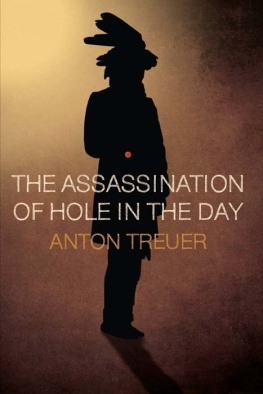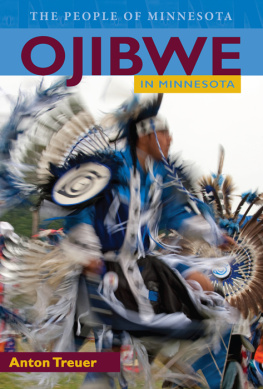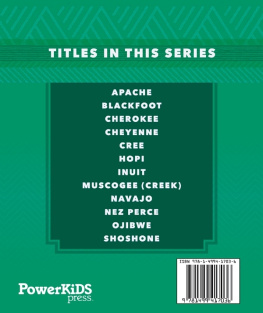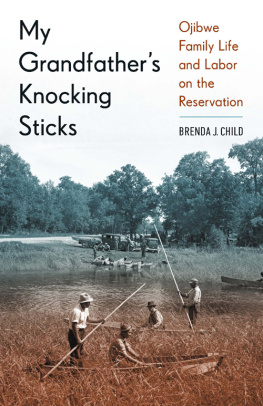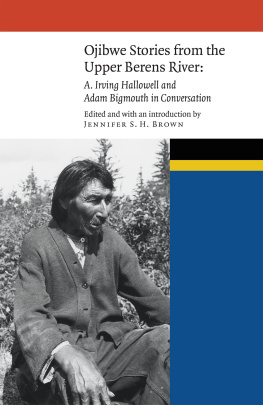The Assassination of Hole in the Day
The Assassination
of Hole in the Day
ANTON TREUER

Borealis Books is an imprint of the Minnesota Historical Society Press.
www.borealisbooks.org
2011 by the Minnesota Historical Society. All rights reserved. No part of this book may be used or reproduced in any manner whatsoever without written permission, except in the case of brief quotations embodied in critical articles and reviews. For information, write to Borealis Books, 345 Kellogg Blvd. W., St. Paul, MN 55102-1906.
The Minnesota Historical Society Press is a member of the Association of American university Presses.
Manufactured in the united States of America
10 9 8 7 6 5 4 3 2 1
The paper used in this publication meets the minimum requirements of the American National Standard for Information SciencesPermanence for Printed Library Materials, ANSI Z39.481984.
International Standard Book Number
ISBN: 978-0-87351-779-9 (cloth)
ISBN: 978-0-87351-801-7 (e-book)
Library of Congress Cataloging-in-Publication Data
Treuer, Anton.
The assassination of Hole in the Day / Anton Treuer. p. cm.
Includes bibliographical references and index. ISBN 978-0-87351-779-9 (cloth : alk. paper) ISBN 978-0-87351-801-7 (e-book) 1. Hole-in-the-Day, Chief, 18281868Assassination. 2. Ojibwa IndiansKings and rulersBiography. 3. Ojibwa IndiansHistory19th century. 4. Ojibwa IndiansGovernment relations. 5. Ojibwa IndiansTreaties. 6. Indian leadershipMinnesotaHistory19th century. 7. MinnesotaHistory19th century. 8. MinnesotaRace relationsHistory19th century. 9. Ojibwa language. 10. Oral history. I. Title.
E99.C6H648 2010
977.6004970092dc22
[B]
2010023347
Maps by David Deis. Image on page 19 by John Swartz. Images on pages 120, 157, and 158 courtesy National Museum of the American Indian. All other images in MHS collections.
For my father, Robert Treuer, who told me stories about the chiefs named Bagone-giizhig and sparked my interest in them, the field of history, and the pursuit of knowledge.
Maps
Ojibwe Band Locations in Minnesota

Preface
Archives, Oral History, and the Ojibwe Language
Should the future historian include in his annals a list of noted men few will be more conspicuous or attract more attention than that of Hole-in-the-Day.
B, LETTER TO THE ST. CLOUD TIMES, JULY 11, 1868
RESEARCHING AND WRITING ABOUT HOLE IN THE DAY
I first developed an interest in Bagone-giizhig (Hole in the Day) as a small child. Traveling with my family throughout Minnesotas lake country, I listened to my fathers stories about the father and son chiefs, Fort Ripley, and other people and places of importance. As an adult I returned to those stories, people, and places determined to fill in the missing pieces and discover who really killed Bagone-giizhig the Younger and how the Ojibwe lost control of so much of the most beautiful land in the world.
As I delved deeper into the father and son named Bagone-giizhig and the history of Ojibwe-Dakota relations, treaties, and removals, I found a wealth of information by modern scholars and some of Minnesotas best-known early writers. Henry R. Schoolcraft, William W. Warren, George Copway (also known as Gaagigegaabaw [Stands Forever]), Samuel Pond, Johann Georg Kohl, and many other officials, missionaries, scholars, and politicians wrote about Bagone-giizhig the Younger. Some of them knew him and had witnessed him in action negotiating with American officials and Dakota leaders; others published biographical sketches or lengthy accounts of both men named Bagone-giizhig in journals and correspondence. Both the father and son had impressed the observers with their physical presence, intelligence, the way they spoke, and the substance of their political endeavors. I wanted to know more.
I began digging in the Minnesota Historical Society and National Archives, searching the Aspinwall, Pond, Sibley, Bassett, Ramsey, Manney, Spears, and Whipple papers, as well as the personal correspondence of most of Minnesotas early politicians and military figures stationed in Minnesota. There was clearly enough material in the archives to write a biography of the younger Bagone-giizhig. However, in order to do him justice, I felt it necessary to know what Ojibwe people thought about him.
I am Ojibwe, a lifelong resident of the greater Leech Lake area, and a fluent speaker of the Ojibwe language. I traveled extensively throughout Minnesota and Wisconsin for many years to attend Big Drum ceremonies, apprenticed to Archie Mosay at summer Midewiwin initiations on the St. Croix Reservation, and researched Ojibwe language, history, and culture. I wondered if the respected elders I knew, the most eloquent Ojibwe language speakers alive today, had information or perspective on the chiefs I was studying and if their knowledge differed from the archival information. All I had to do was ask them.
I was both surprised and delighted at the depth of knowledge that many Ojibwe people retained about the lives of the long-dead chiefs. For example, when I visited Melvin Eagle, a Mille Lacs elder, to learn about the music and speeches of the ceremonial Big Drum, he was able to speak for two hours about Bagone-giizhig. Melvin Eagle is the grandson of Chief Migizi (Eagle), who was chief in Mille Lacs when Bagone-giizhig was chief in the Gull Lake region. Migizi and the head warrior from Mille Lacs, Niigaanigwaneb, had actually sent warriors to protect Fort Ripley in 1862 during the U.S.Dakota Conflict because Bagone-giizhig had threatened to take over the fort and join the Dakota in a large-scale war with whites in Minnesota. Fort Ripley was not only the seat of U.S. military presence in Ojibwe country; it was also the focal point of a major military stand-off between the Ojibwe and the U.S. government in 1862 engineered by Bagone-giizhig the Younger while a larger conflict embroiled the Dakota and Americans. Melvin Eagle told me how his father and grandfather had been entrusted with keeping oral histories as part of their hereditary leadership duties. Now I had someone who could say not simply, Heres what the elders say, but rather, Here is what my grandfather told me about what he did, and here is why he did it. Melvin Eagle was a gold mine of information about Bagone-giizhig, the chiefs contentious relationship with the leaders in Mille Lacs, and his actions in 1862, at treaty signings, and in attacking the Dakota.
Archie Mosay, who was born in 1901, also knew a great deal about Bagone-giizhig. His father had been born in a wigwam near Sandy Lake, where Bagone-giizhig the Elder and his people lived before settling new villages in the Gull Lake region. Mosay and Bagone-giizhig were cousins. The evidence Mosay presented was not merely anecdotal. It helped me better understand the nature of Ojibwe chieftainship and how the culture of the Ojibwe people informed leadership dynamics.
I spent a great deal of time speaking with Joseph Auginaush of White Earth, who shared stories about Bagone-giizhig. He showed me a copy of a grocery receipt for twenty-four dollars that the local trader had used to assume title to his fathers original land allotment against the will of the Auginaush family and without a hearing, service of notification papers, or due process of law. This information confirmed allotment abuses at White Earth after Bagone-giizhigs assassination. The information would never have been accessible had I confined myself to archival research. I also had several conversations with Bagone-giizhig the Youngers great-great-granddaughter, Karen Fairbanks, and other relatives now living at White Earth. Their insights into his actions and legacy contributed greatly to my expanding understanding and evolving interpretations of the chiefs.

